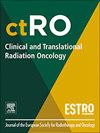Patient-reported outcomes between proton and photon therapy in nasopharyngeal carcinoma patients: A longitudinal cohort study
IF 2.7
3区 医学
Q3 ONCOLOGY
引用次数: 0
Abstract
Background and purpose
This study aimed to compare patient-reported outcomes (PROs) between intensity-modulated proton therapy (IMPT) and volumetric-modulated arc therapy (VMAT) in treating nasopharyngeal carcinoma (NPC).
Materials and methods
A prospective cohort study was conducted at a tertiary care center from 2021 to 2023. Newly diagnosed NPC patients were assessed using the modified 28-item symptom distress scale at seven time points, from baseline (T0) to one year post-radiotherapy (RT) (T6). The analysis focused on symptom changes during the acute phase (T0 to T3 [one month post-RT]) using linear mixed models. Sensitivity analyses incorporated inverse probability treatment weighting and data from non-metastatic patients adhering to survey protocols.
Results
IMPT recipients (n = 65) had higher education levels, marital stability, household incomes, and better performance statuses compared to VMAT recipients (n = 36). Oral-related symptoms peaked by the seventh week of RT and declined thereafter. IMPT significantly reduced “oral ulcer” (coefficient: −0.83, SE: 0.27) and “difficulty opening mouth” (coefficient: −0.44, SE: 0.18) symptoms by the seventh week but did not improve “dry mouth.” “Tinnitus” was rated as more distressing than “hearing difficulty,” with no significant differences between IMPT and VMAT for ear-related symptoms. Sensitivity analyses validated these findings.
Conclusion
IMPT was associated with reduced severity of specific oral-related symptoms during the acute phase of RT compared to VMAT. While these findings suggest potential benefits of IMPT, baseline differences between groups necessitate cautious interpretation and further validation through randomized studies.
鼻咽癌患者报告的质子和光子治疗的疗效:一项纵向队列研究
背景与目的本研究旨在比较调强质子治疗(IMPT)和体积调节电弧治疗(VMAT)治疗鼻咽癌(NPC)患者报告的预后(PROs)。材料与方法前瞻性队列研究于2021 - 2023年在某三级保健中心进行。从基线(T0)到放疗后1年(T6),在7个时间点使用改良的28项症状困扰量表对新诊断的NPC患者进行评估。采用线性混合模型分析急性期(T0 ~ T3 [rt后1个月])的症状变化。敏感性分析纳入了反概率治疗加权和非转移性患者遵守调查协议的数据。结果simpt受术者(n = 65)比VMAT受术者(n = 36)具有更高的受教育程度、婚姻稳定、家庭收入和更好的工作状态。口腔相关症状在放疗第7周达到顶峰,此后逐渐下降。到第七周时,IMPT显著减轻了“口腔溃疡”(系数:- 0.83,SE: 0.27)和“开口困难”(系数:- 0.44,SE: 0.18)症状,但没有改善“口干”。“耳鸣”被评为比“听力困难”更令人痛苦,IMPT和VMAT在耳朵相关症状方面没有显着差异。敏感性分析证实了这些发现。结论与VMAT相比,impt与RT急性期特异性口腔相关症状的严重程度降低有关。虽然这些发现表明IMPT的潜在益处,但两组之间的基线差异需要谨慎解释,并通过随机研究进一步验证。
本文章由计算机程序翻译,如有差异,请以英文原文为准。
求助全文
约1分钟内获得全文
求助全文
来源期刊

Clinical and Translational Radiation Oncology
Medicine-Radiology, Nuclear Medicine and Imaging
CiteScore
5.30
自引率
3.20%
发文量
114
审稿时长
40 days
 求助内容:
求助内容: 应助结果提醒方式:
应助结果提醒方式:


